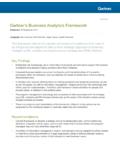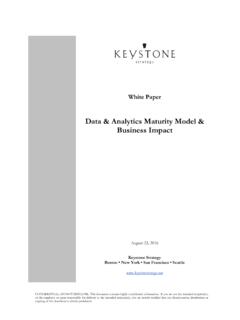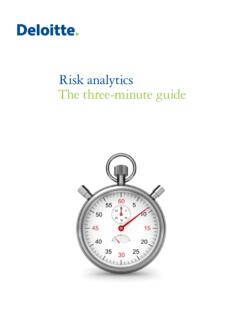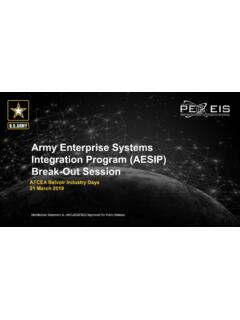Transcription of The Enterprise Data Analytics Strategy - United States Army
1 Department of the army The Enterprise Data Analytics Strategy for army Business 2018-2022. INFORMATION COMPILED BY: The Office of Business Transformation The reference to commercial or non-government entities or products in this document does not constitute an official endorsement or approval. I. Purpose Through its goals and objectives, the EDAS establishes a trajectory for the army in building Enterprise -wide decision Analytics capabilities that capture the full business value of army information resources. The army will develop best-in-class Analytics doctrine, organization, training, materiel, leadership and education, personnel, facilities, and policy (DOTMLPF-P) capabilities for a data-driven culture to drive fact-based, resource-informed decisions that generate readiness at best value. II. Strategic Intent army leaders are often forced to make inductive decisions because they lack access to timely and accurate predictive, inferential, or causal analysis that links resource decisions and proposed courses of action to projected outputs or outcomes.
2 This lack of access precludes the army from capturing the full business value of its information resources to identify opportunities and solutions for the improvement of readiness at best value to the Nation. To address this gap, the army has substantially invested in its business information technology over the past 5. years. Advanced Enterprise Resource Planning (ERP) systems have been and continue to be fielded to better manage personnel, logistics, financial, force Figure 1: National Institute of Standards and management, and training operations. Technology Data Science Model More significantly, the army is migrating these systems into an integrated environment to provide the architectural and data management foundations necessary for visibility of overall army Enterprise process performance and cost directly related to readiness. This information environment will have the potential to generate new insights and other capabilities such as Global Force Information Management, the army Contract Writing System, the army Training Information System, and others to inform strategic, fact-based decisions regarding matters that are fundamental to the army 's Title 10 United States Code (USC) responsibilities.
3 While much progress has been made toward materiel solutions to support Enterprise level data analysis, expanding and sustaining the use of army data to capture its full business value will require approaches that go beyond data analysis and data management to incorporate data science (figure 1). 1. To optimize benefits of the integrated ERP environment, the army must mature its approaches to data Analytics . The army must move from descriptive and diagnostic Analytics that are historically based, predominantly transactional, and focused on performance evaluation toward enabling predictive and prescriptive Analytics . This maturation will provide the army with the ability to generate readiness and to answer questions about what is likely to happen, what can be done to make things happen, and how to take advantage of opportunities or mitigate risks as events unfold (figure 2). Figure 2: The Analytics Continuum These approaches to data Analytics must also address the full spectrum of DOTMLPF-P.
4 Considerations. Further, the maturation of data Analytics in the army will require the definition of roles and responsibilities and the synchronization of organizations already working to support this capability across a number distributed communities of practice. The EDAS provides overarching direction to address these requirements and, in doing so, plays a vital role in the improving the way the army mans, trains, and equips the force. III. Strategic Narrative The army must advance its data Analytics capability to a maturity level in which data is a driver of continuous improvement and innovation. Information must be regarded as a 2. strategic asset. Analytical insight must optimize business process performance. Information governance must be integrated into all aspects of business processes to improve readiness. IV. Planning Cycles and Strategic Alignment As an enabling Strategy to the Department of Defense Agency Strategic Plan and the army Strategic Plan, the EDAS is aligned to, and synchronized with, other army functional strategies, particularly the army Data Strategy , the army Business Strategy , and the army Innovation Strategy .
5 At the same time, EDAS provides overarching and unifying direction for operations, programs, and initiatives already using data Analytics and data science to address specific army challenges (figure 3). Figure 3: Enterprise Data Analytics Strategy Alignment The Strategy has a 5-year planning horizon and is reviewed and updated biannually to ensure continued responsiveness to the army 's evolving strategic environment. Updates to the EDAS will subsequently be published by the Office of Business Transformation (OBT) during the first quarter of the fiscal year. V. Governance and Assessment The Chief Management Officer is responsible for development and coordination of the EDAS and OBT facilitates the assessment of performance related to its objectives. This 3. assessment is accomplished through the Two and Three-Star army Business Council (ABC) meetings with updates provided as appropriate to the Senior Review Group (SRG), chaired by the Under Secretary of the army (USA) and the Vice Chief of Staff of the army (VCSA).
6 While the primary purpose for the reviews is to monitor progress, ABC venues provide army senior leaders with the opportunity to engage in overcoming obstacles or necessary decision-making in the achievement of EDAS objectives. The army 's Strategic Management System (SMS) facilitates measurement of progress against strategic objectives and is the directed, Enterprise -level tool used to manage Strategy execution in the army to include the EDAS. VI. Strategic Goals, Objectives, and Performance Measures A. Data Analytics Doctrine and Policy Challenge: Data Analytics can create tremendous value for organizations by collecting novel sources of data, combining data in novel ways, and analyzing data with novel methods. But the nature of data Analytics poses challenges for established, bureaucratic institutions as it requires innovation, experimentation, and discovery;. ascribes value to data itself; and has clear return on investment (ROI) metrics.
7 Processes such as acquisition, budgeting, and even strategic decision-making must adapt to the rapidly evolving tools and capabilities of data Analytics . Goal 1: army Data Analytics doctrine and policy adapt new capabilities to the army 's circumstances. The army is oriented and organized around fast experimentation to understand, learn, and improve its business operations through data Analytics and, as a result, continuously improves army readiness. Objective : Establish formalized governance for the army to develop overarching policy and guidance for the army Enterprise approach to data Analytics , translate strategic leadership questions into data projects, and harmonize previously disparate Analytics management efforts. Performance Indicator : Establish an army Analytics Board (AAB) with representation from across Headquarters, Department of the army (HQDA). Target: The AAB is established with initial meeting conducted no later than (NLT) 3rd quarter (Qtr), fiscal year 2019 (FY19).
8 Performance Indicator : The AAB maintains and manages a portfolio of data Analytics activities and a project pipeline with an optimal mix of core, adjacent, and transformational projects that will allow the army to best mitigate technical, implementation, and adoption risks. Target: NLT 4th Qtr, FY19. Objective : Provide authoritative direction for the army 's approach to data Analytics . 4. Performance Indicator : The army 's approach to data Analytics and data science is codified in army Regulation (AR) 5-1 (Management of army Business Operations). Target: With first revision of AR 5-1 after the publication of this Strategy . B. Data Analytics Organization and Infrastructure Challenge: An Enterprise data Analytics capability that includes people, platforms, and tools can be organized in a variety of ways that suits the particular needs of an Enterprise . Within the army today there is some centralization of data and data governance with a focus on the collection, storage, and governance of data but this is not sufficient for the strategic use of those assets.
9 Further, organization of the army 's data Analytics capability must address cross-functional, Enterprise -wide issues of strategic value, incentivizing innovation, and enabling agility. This challenge will require Enterprise level management of the army 's approaches to data Analytics . Goal 2: The army establishes a federated approach to data Analytics and data science that provides a mandate, incentives, and opportunity for the growth and maturation of this capability while supporting the further development of establishment of data Analytics cells at other echelons and leveraging existing capabilities currently dispersed across the army (figure 4). Figure 4: Federated Approach to Data Analytics for army Business 5. Objective : Establish a data Analytics cell resident within HQDA with leadership formally designated as the army 's Chief Analytics Officer (CAO) to focus on Enterprise - level questions. With the addition of expertise in the areas of data science, data management, communications, and subject matter expertise, and with the stand-up of the army Analytics Board, the cell evolves to become the army 's Analytics Center of Excellence (ACE) with responsibility for developing and deploying related strategic direction throughout the army , solving the hardest Enterprise questions and maturing the broader data Analytics community.
10 Performance Indicator : CAO position designated, filled, and data analysis cell established. Target: 3rd Qtr, FY19. Performance Indicator : ACE is formally established and is at initial operating capacity. Target: End of FY19. Objective : Organize and conduct collaborative Armywide events such as Unified Quest or similar challenges to engage and build relationships across government, industry, and academia in advancing the army 's data Analytics and data science capability. Performance Indicator : The army conducts collaborative, Armywide events to advance its data Analytics capability. Target: Minimum of one event annually beginning in FY19. Objective : Strengthen the army 's data Analytics community of practice through a federated organizational structure where there is a balance of centralized and distributed coordination and a centralized group of advanced analysts, strategically deployed to Enterprise -wide initiatives (figure 4).

















